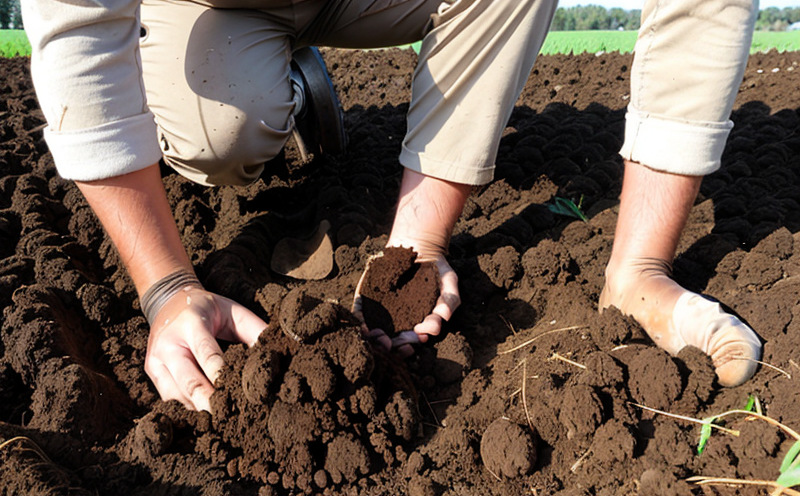Soil Boron Content Testing
In agriculture and forestry testing, soil boron content is a critical parameter that influences plant growth, crop yield, and overall soil health. Boron plays a unique role in plant physiology as it is essential for cell wall formation, protein synthesis, and carbohydrate metabolism. A deficiency or excess of boron can lead to significant yield losses and nutrient imbalances.
Soil boron content testing is particularly important for crops such as alfalfa, almonds, citrus fruits, and other stone fruits where boron requirements are higher than the general crop norm. Understanding the boron levels in soil ensures that growers can make informed decisions regarding fertilizer application rates and types to avoid deficiencies or toxicities.
The International Organization for Standardization (ISO) provides guidelines on soil sampling methods, which should be followed meticulously to ensure accurate results. Proper sample preparation is crucial; this involves taking subsamples from a larger area at consistent depths and combining them into a composite sample. The sample must then undergo appropriate processing before testing can commence.
The primary instrument used for boron content analysis in soil samples is the atomic absorption spectrophotometer (AAS). This technique measures the concentration of specific elements by determining the amount of light absorbed at a particular wavelength. For boron, the characteristic emission line is around 247.9 nm.
The testing process involves several steps: drying and ashing the soil sample to remove moisture and organic matter; digestion using strong acids like nitric acid or perchloric acid to break down the solid matrix into a solution; dilution of this solution if necessary; and finally, analysis via AAS. The precision and accuracy of these procedures are paramount in ensuring reliable results.
Accurate soil boron content testing is essential for maintaining optimal crop performance and reducing environmental impacts associated with over-fertilization or under-utilization of resources. By identifying the exact boron levels present in the soil, farmers can optimize their nutrient management practices, thereby promoting sustainable agricultural practices.
The results from such tests are typically reported in parts per million (ppm). An optimal range for most crops is between 0.5 ppm and 2 ppm; however, specific thresholds vary depending on crop type. For instance, almond trees require higher levels of boron than other crops, with an ideal range around 1-3 ppm.
Understanding the implications of soil boron content testing extends beyond just agricultural practices. It also plays a role in environmental conservation efforts by helping to manage nutrient cycling and prevent pollution from excess fertilizers entering waterways.
Quality and Reliability Assurance
The quality assurance process for soil boron content testing involves several key steps to ensure accuracy and reliability. First, the laboratory must adhere strictly to ISO standards governing soil sample collection and preparation. This includes using appropriate tools and techniques that minimize contamination risks during sampling.
Once samples are received at the lab, they undergo rigorous quality checks before analysis begins. These include visual inspection for visible contaminants or inconsistencies within the sample. Additionally, duplicate analyses may be conducted on a subset of samples to verify consistency across different test runs.
The equipment used in boron content testing must also be regularly calibrated against known reference materials to maintain accuracy over time. Regular maintenance schedules ensure that all instruments function correctly and consistently produce repeatable results.
Finally, the analytical methods employed should comply with internationally recognized standards such as ISO 17025 for general requirements for the competence of testing laboratories. Compliance with these standards provides assurance not only to internal stakeholders but also to external regulators who may require proof of adherence to best practices.
The reliability of soil boron content tests directly impacts decision-making processes related to crop management and resource allocation within agricultural operations. Accurate information helps ensure that resources are used efficiently, leading to improved productivity without unnecessary costs or environmental harm.
Environmental and Sustainability Contributions
Sustainable agriculture practices emphasize the importance of maintaining ecological balance while meeting current food demands. Soil boron content testing contributes significantly to this goal by providing precise data on essential nutrient availability in soils. This knowledge enables farmers to apply fertilizers more precisely, reducing waste and minimizing environmental impact.
Boron plays a critical role in plant biology; it promotes strong cell walls which help protect plants against diseases and pests. By optimizing boron levels through targeted applications based on test results, crops can be made more resilient to adverse conditions such as drought or temperature fluctuations.
Furthermore, accurate soil boron content testing supports long-term sustainability goals by promoting efficient use of resources. Over-applying fertilizers not only increases production costs but also poses risks to groundwater quality when excess nutrients leach into nearby water bodies. By ensuring that only the necessary amounts are applied, this risk is significantly reduced.
The reduction in chemical runoff also benefits local ecosystems, preserving biodiversity and supporting healthy aquatic habitats. This approach aligns with broader environmental protection initiatives aimed at mitigating climate change impacts through sustainable land use practices.
Use Cases and Application Examples
Soil boron content testing finds application in various scenarios within the agricultural sector, including field trials, farm management strategies, and precision agriculture initiatives. Field trials often begin with soil boron content analysis to establish a baseline for future comparisons.
In farm management, regular testing allows farmers to monitor changes over time due to natural processes or interventions like irrigation practices. Precision agriculture leverages this information for real-time adjustments in nutrient application rates based on precise field-by-field conditions.
For instance, almond orchards benefit greatly from periodic soil boron content assessments because these trees have higher requirements compared to other crops. By integrating test results into their overall management plans, growers can maintain optimal tree health and maximize fruit production.
Agronomists also use this data when advising clients on best practices for different crop types. Knowledge about local soil conditions helps tailor recommendations effectively, enhancing both profitability and sustainability of operations across diverse geographical locations.





